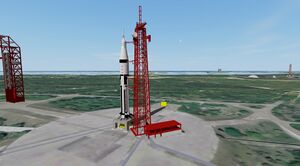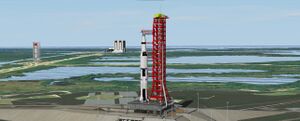First Steps
|
After you finished the Installation of the latest beta version the Project Apollo scenarios are in the "Project Apollo - NASSP" scenario folder and subfolders. Because of the ongoing development many of the scenarios and missions are not working yet, they are in the "Broken Scenarios" folder.
Project Apollo - NASSP supports different levels of complexity or realism modes, so you can adjust the difficulty level you want to use. You choose the desired mode by choosing the appropriate scenario. At the moment Quickstart Mode is available for beginners, while Virtual AGC Mode is intended for the advanced user.
Quickstart Mode
| ||
| Quickstart missions are no longer supported. Consider using the Virtual AGC scenarios. |

The Quickstart mode is intended for beginners, who are already familiar with Orbiter in general, but don't have much particular knowledge about Apollo and the historic spacecraft. If you aren't familiar with Orbiter yet, we suggest to try the built-in Deltaglider at first.
In Quickstart mode as much as possible is done automatically and the spacecraft behave as much as possible like standard Orbiter spacecrafts. It's only very rarely necessary to use the panel. All (or almost all) critical maneuvers are done by autopilot and you can also fly the spacecraft more "Orbiter like" than the real Apollo spacecraft. The Simple AGC is used as Apollo Guidance Computer (AGC).
This mode is currently the only mode that can effectively fly a complete moon landing mission. There is a (in progress) tutorial and checklist page Quickstart to the Moon.
Missions
The following missions and scenarios are available for Quickstart mode:
Virtual AGC Mode

The Virtual AGC mode is intended for the advanced users, who already have some basic knowledge about the Apollo missions, are familiar with Orbiter and now want to do it like the real astronauts did.
In Virtual AGC mode everything is as authentic as possible and you have to fly the mission (almost) like the real thing. You have to do long checklists and control the internal systems manually. The spacecrafts behave more like the real ones, the S-IVB is restartable only once for example.
A very important device of the Apollo spacecraft is the Apollo Guidance Computer (AGC), which normally does the guidance, navigation and control tasks. In this mode, the Virtual AGC, an Apollo Guidance Computer emulator running the original, authentic Apollo flight software (at the moment Colossus 1A, build 249 from October 28, 1968, flown with Apollo 9) is used. With the Virtual AGC you can do all procedures exactly as described in the original documentation.
| ||
| Because of the AGC hardware emulation time acceleration higher than about 10x is not recommended as long as the guidance computer is turned on. |
On real Apollo missions, many things went wrong, mostly minor. In Virtual AGC mode, some of these failures are simulated at the appropriate time in the mission. So be sure to perform your control panel checks and work around any failures which do occur.
Missions
The following missions and scenarios are available for Virtual AGC mode:
Checklists
The following checklists are available for Virtual AGC mode:
Annotated checklists in Word file format
are in the Doc\Project Apollo - NASSP\Checklists folder of your installation.
Project Apollo Checklist MFD
For Virtual AGC Mode Project Apollo Checklist MFD provides in-game checklists. It can execute checklists automatically, so to watch the show do the following:
- Start Orbiter, go to the "Extras" tab of the Orbiter launchpad, double-click Vessel configuration and then double-click Project Apollo Configuration.
- Go to the "Virtual AGC Mode" tab and activate both the "Enable automatic checklist execution" and the "Slow automatic checklist execution (e.g. for demonstrations)" option.
- Start the "Project Apollo - NASSP/Apollo 7 Virtual AGC - Launch" scenario. Choose "Start paused" if you don't want to miss the first steps.
- Press F1, F4, choose "Custom, then "External MFD".
- Select the "Project Apollo Checklist" MFD.
- Press FLSH to highlight the switch of the current step (if applicable)
- Unpause Orbiter and enjoy the show!
Unmanned Missions
A few unmanned Apollo missions are supported. The missions run automatically, simply activate time acceleration and wait for the next event. time acceleration will be deactivated a few minutes beforehand.
Fictional Missions
Scenarios in Fictional missions directory:
Documentation
As always, be sure to review documentation relevant to your mission. The Missions and Spacecraft pages are good places to begin (work in progress).